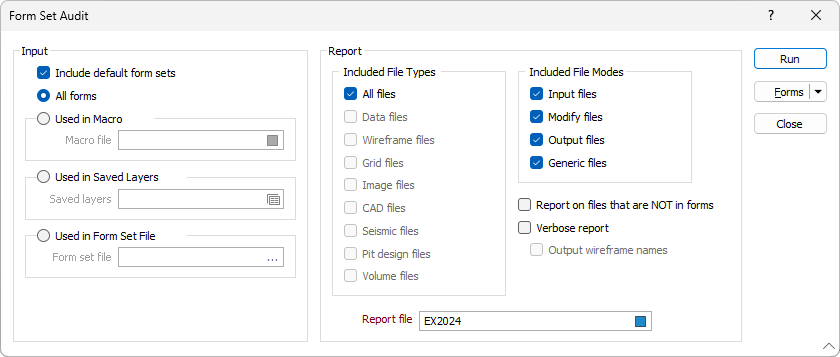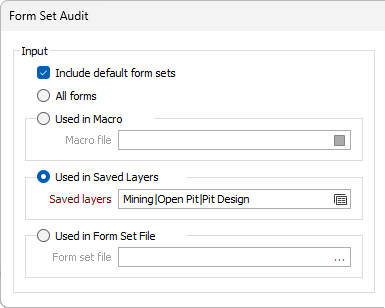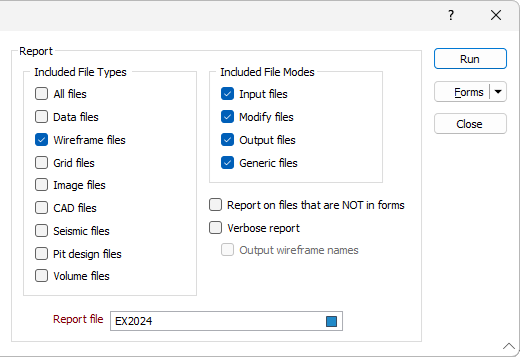Audit
![]()
By interrogating multiple forms you can:
-
generate a list of "existing" and "missing" files
-
generate a list of "files" that are in the project folder, but are not referenced by any forms

Input
Choose which project forms to include in the form set audit.

Include default form sets
Select this check box to include default form sets.
Default form sets are provided by the application for every form and will always exist irrespective of the project. Default form sets also include system form sets for such things as colour palettes, coordinate system definitions and plot layouts, etc.
Note that default form sets are excluded from the audit if they do not reference files.
All forms
By default, all the forms in the project's form sets database are included in the form set audit.
Used in Macro
Select this option to restrict the form set audit to all the form sets referenced in a macro. Click on the Select icon to select a macro file.
Used in Saved Layers
Select this option to restrict the form set audit to all the form sets referenced in saved Vizex layers. Click on the forms icon to select the saved layers.
Used in Form Set File
Select this option to restrict the form set audit to all the form sets referenced in an exported form set file (*.mmsetx). Click on the ellipsis to select a form set file.
Report
Optionally, filter the report by specifying one or more file types and file modes to include, the scope of the report, and the name of the Report file.

Included File Types
All file types are included by default. To customise your selection, deselect the All files check box. This will enable the remaining check boxes.
Included File Modes
Use the check boxes to restrict the audit to one or more file modes.
File Modes (whether each file is an "Input", "Modify", "Output", or "Generic" file) are determined by the type and the verification mode of each file. For more information, see: File Verification
Report
When not in verbose mode, the audit report is split into two sections, or three sections if files that are NOT referenced in the selected forms are chosen to be reported. See item 2 below.
-
REFERENCED FILES (FOUND)
These are files that are found (they exist) which referenced by the selected form sets and which meet the (input/output, etc) selection criteria.
-
REFERENCED FILES (NOT FOUND)
These are files that are referenced by the selected form sets and meet the selection criteria, but could NOT be found (i.e. are missing). The following check box option must be selected:
Report on files that are NOT in forms
Note that the Verbose report check box option (below) is disabled when this check box is selected.
-
FILES NOT REFERENCED BY SELECTED FORMS/FILE MODES
This list includes all files that were found in the project folder and its sub folders, but which were not included in the previous two sections. In other words, they were not referenced by the selected form sets and/or did not meet the selection criteria.
Only the filepath/name, the number of references from forms, and the number of references from files, are included in this report. File references from files may include Interval files that are referenced from a drillhole database, or the georeference files associated with an image file, etc.
Note that files can be included in both lists, if the file is both referenced by selected forms (and is referenced as a selected input/output type) and by forms that do not meet the selection criteria (or the file is referenced as a non-selected input/output type); these files will display a "No. Form Refs" or "No. File Refs" number in the report to indicate that they have been referenced outside of the selection criteria.
For example:
-
You are reporting on all of your forms, but only outputting the files that are used as input files.
-
You have a file named “file.dat”.
-
“file.dat” gets used as an input in three different forms so it will be listed under “REFERENCED FILES (FOUND)” with a “No. Form Refs” value of 3.
-
“file.dat” gets used as an output in two different forms so it will be listed under “FILES NOT REFERENCED BY SELECTED FORMS/FILE MODES” with a “No. Form Refs” value of 2 (because Output files were not included in the report criteria).
Verbose Report
This outputs the form set name and ID, the parent file name (if the file is referenced by a file rather than a form), the file's relative path, the file type (extension), whether the file exists or is missing, and whether the file is considered an "Input", "Modify", "Output", or "Generic" file, and the number of referenced wireframes (if the file is a .tridb file).
In verbose mode, the report is split into three sections:
-
FILE REFERENCES FROM FORM SETS
These are the files that are referenced by the selected form sets and which meet the selection criteria. This section lists each file reference with the Form Set Name/ID that references the file. Additional information includes whether the file exists, or is missing, and the file mode (Input, Modify, Output or Generic).
Additionally, if the option for outputting referenced wireframes is selected, a list of referenced wireframe names will follow any referenced .tridb file. Note that Wireframe names are prefixed with a "- ", as are files that are referenced with their parent file names enclosed in square brackets.
-
FILE REFERENCES FROM FILES
(If any) These are the files that are referenced by files that are referenced by the selected form sets and which meet the selection criteria. This section also lists which file each entry is referenced by.????
-
SUMMARY: ALL REFERENCED FILES (FROM FORMS AND FILES)
A list of referenced files with the following additional information: file mode, whether the file exists or is missing, the number of form sets that reference the file, and the number of files that reference the file.
Records in the Summary report are sorted by file type. Files of the same file type are grouped together and are sorted alphabetically within their group.
Output wireframe names
This check box option is only enabled when the Verbose Report check box (above) is selected. If selected, this option will list all of the referenced wireframe names for each referenced wireframe type.
The "Parent File/Form Set" column on each row of the report will contain the .tridb file name.
Note that the file mode of a wireframe type is classified as either Input or Output:
-
If a Wireframe Name field is referenced in a form, then the selection of a Wireframe Type will prompt the user for the name of an input wireframe of that type.
-
Wireframe Type controls which do not reference a Wireframe Name field are assumed to be outputs.
Report file
Enter (or double-click or click on the Select icon to select) the name of the Report file to which the results of the audit will be written. You will be prompted to overwrite or append to an existing file.